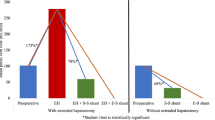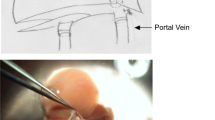Abstract
Background
When residual liver volume is extremely small after extended hepatectomy, postoperative hepatic failure may ensue. The cause of the hepatic failure is likely associated with the portal hypertension after hepatectomy. We investigated the effects of portocaval shunt on portal hypertension in producing sinusoidal microcirculatory injury after extended hepatectomy in pigs.
Methods
Fourteen pigs were divided into two groups: a group without a shunt, in which extended hepatectomy was carried out (i.e., residual volume was 17% of the whole liver), and a group with a shunt, in which extended hepatectomy was carried out and a portocaval shunt was inserted. The portocaval shunt was placed by side-to-side anastomosis between the portal vein and the inferior vena cava.
Results
In the group without a shunt, all pigs died of hepatic failure within postoperative day 3. In the group with a shunt, all pigs were alive for more than 4 days, and 4 pigs survived longer than 7 days. Portal vein pressure after hepatectomy was 15.9 ± 3.8 mmHg in the group without a shunt and 10.5 ± 0.6 mmHg in the group with a shunt (P < 0.01). The portal vein flow after 83% hepatectomy in the group without a shunt increased significantly more than at laparotomy and in the group with a shunt (P < 0.01). In the group without a shunt, remarkable destruction of the sinusoidal lining and edema of the portal triad and hydropic change of hepatocytes were observed 1 hour after hepatectomy, but these findings were not observed in the group with a shunt.
Conclusions
These results indicate that, after extended hepatectomy, overload of portal flow is one of the most significant risk factors of hepatic failure by sinusoidal microcirculatory injury.






Similar content being viewed by others
References
Casavilla FA, Marsh JW, Iwatsuki S, et al. Hepatic resection and transplantation for peripheral cholangiocarcinoma. J Am Coll Surg 1997;185:443–451
Aronsen KF, Grundsell H, Johansson BW, et al. Hemodynamic effects of partial hepatectomy in dogs. Acta Chir Scand 1969;135:320–324
Oliver RH, Sutton PM. The effects of partial hepatectomy on portal pressure in rats. Br J Surg 1966;53:138–141
Lee SS, Hadengue A, Girod C, et al. Reduction of intrahepatic vascular space in the pathogenesis of portal hypertension. In vitro and in vivo studies in the rat. Gastroenterology 1987;93:157–161
Nagasue N, Yukaya H, Ogawa Y, et al. Portal pressure following partial to extensive hepatic resection in patients with and without cirrhosis of the liver. Ann Chir Gynaecol 1983;72:18–22
Kanematsu T, Takenaka K, Furuta T, et al. Acute portal hypertension associated with liver resection. Analysis of early postoperative death. Arch Surg 1985;120:1303–1305
Sirinek KR, Thomford NR. The effect of vasopressin on portal hypertension following hepatectomy. Surg Gynecol Obstet 1974;139:573–577
Stone HH, Long WD, Smith RB 3rd, et al. Physiologic considerations in major hepatic resections. Am J Surg 1969;117:78–84
Ueno S. An experimental study on the correlation between hepatic hemodynamics and ultrastructural and immunohistochemical changes of sinusoidal endothelial cells after major hepatectomy. Jpn J Surg 1994;95:248–258
Ueno S, Kobayashi Y, Kurita K, et al. Effect of prior portosystemic shunt on early hepatic hemodynamics and sinusoids following 84% hepatectomy in dogs. Res Exp Med 1995;95:1–8
Koga A, Fukuyama T, Momii S. Subcutaneous transposition of the spleen enhances the survival rate following 90% hepatectomy in rats. Experientia 1989;45:457–459
Fukuchi T, Hirose H, Onitsuka A, et al. Effects of portal-systemic shunt following 90% partial hepatectomy in rats. J Surg Res 2000;89:126–131
Szawlowski AW, Saint-Aubert B, Gouttebel MC, et al. Experimental model of extended repeated partial hepatectomy in the dog. Eur Surg Res 1987;19:375–380
Mitsumoto Y, Dhar DK, Yu L, et al. FK506 with portal decompression exerts beneficial effects following extended hepatectomy in dogs. Eur Surg Res 1999;31:48–56
Wang HS, Enomoto Y, Usuda M, et al. Excessive portal flow causes graft nonfunction in small size liver transplantation: an experimental study in pigs. Transplant Proc 2005;37:407–408
Court FG, Laws PE, Morrison CP, et al. Subtotal hepatectomy: a porcine model for the study of liver regeneration. J Surg Res 2004;16:181–186
Atkinson DE, Chapman AG. The adenylate energy charge in the study of enzymes in vitro. Methods Enzymol 1979;55:229–235
Seya K, Ohkohchi N, Watanabe N, et al. Rapid fluorometric assay for mitochondrial proton adenosine triphosphatase activity for assessment of viability of liver graft tissue. J Clin Lab Anal 1994;8:418–423
Haug CE, Jenkins RL, Rohrer RJ, et al. Liver transplantation for primary hepatic cancer. Transplantation 1992;53:376–382
Gaub J, Iversen J. Rat liver regeneration after 90% partial hepatectomy. Hepatology 1984;4:902–904
Kato K, Matsuda M, Kusano M, et al. The immunostimulant OK-432 enhances liver regeneration after 90% hepatectomy in rats. Hepatology 1994,19:1241–1244
Iso A, Usami M, Kasahara H, et al. Bacterial translocation induces remnant liver injury after subtotal (90%) hepatectomy in rats—the effect of decontamination of gram-negative rods in digestive tract by oral polymyxin B treatment. Jpn J Dig Dis 1996;93:544–552
Zhang XK, Gauthier T, Burczynski FJ, et al. Changes in liver membrane potentials after partial hepatectomy in rats. Hepatology 1996;23:549–551
Tuczek HV, Rabes H. Loss of proliferation capacity of hepatocytes following subtotal hepatectomy. Experientia 1971;27:526
Vic P, Saint-Aubert B, Astre C, et al. Complete liver regeneration in one-stage 90% hepatectomized rats treated with testosterone. Hepatology 1982;2:247–248
Habib NA. Early mortality in 100 consecutive liver resections in 96 patients with benign and malignant liver tumours. Ann R Coll Surg Engl 1995;77:107–110
Fisher B, Lee SH, Fisher ER, et al. Liver regeneration following portacaval shunt. Surgery 1962;52:88–102
Sato Y, Koyama S, Tsukada K, et al. Acute portal hypertension reflecting shear stress as a trigger of liver regeneration following partial hepatectomy. Surg Today 1997;27:518–526
Mito M, Ackroyd FW, Covelli VH, et al. Partial heterotopic liver homograft in dogs utilizing portal arterialization. Ann Surg 1967;165:20–32
Starzl TE, Francavilla A, Halgrimson CG, et al. The origin, hormonal nature, and action of hepatotrophic substances in portal venous blood. Surg Gynecol Obstet 1973;137:179–199
Barbare JC, Poupon R, Jaillon P, et al. The influence of vasoactive agents on metabolic activity of the liver in cirrhosis: a study of the effects of posterior pituitary extract, vasopressin, and somatostatin. Hepatology 1984;4:59–62
Braillon A, Jiron MI, Valla D, et al. Effect of propranolol on hepatic blood flow in patients with cirrhosis. Clin Pharmacol Ther 1985;37:376–380
Mosimann R, Marquis C, Mosimann F, et al. Long-term follow-up after a distal splenorenal shunt procedure. A clinical and hemodynamic study. Am J Surg 1983;145:253–255
Vinel JP, Caucanas JP, Cales P, et al. Effect of propranolol on metabolic activity of the liver in patients with alcoholic cirrhosis. J Hepatol 1988;7:186–192
Acknowledgements
This work was supported by grants-in-aid for scientific research from the Ministry of Education, Science, and Culture of Japan, the Ministry of Welfare of Japan, and by a grant from the Graduate School of Medicine, Tohoku University.
Author information
Authors and Affiliations
Corresponding authors
Additional information
This study was presented at the Fourth International Meeting on Hepatocellular Carcinoma: Eastern and Western Experiences, Hong Kong, China, December 14–16, 2004
Rights and permissions
About this article
Cite this article
Wang, H., Ohkohchi, N., Enomoto, Y. et al. Effect of Portocaval Shunt on Residual Extreme Small Liver after Extended Hepatectomy in Porcine. World J. Surg. 30, 2014–2022 (2006). https://doi.org/10.1007/s00268-005-0294-4
Published:
Issue Date:
DOI: https://doi.org/10.1007/s00268-005-0294-4




